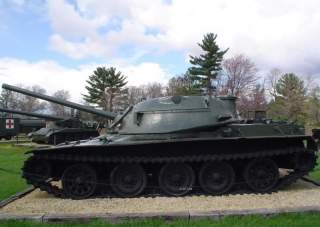Meet the T-95 Tank: The Super Weapon America Never Built
Was it just too far ahead of its time?
After the end of World War II, tank design underwent a revolution. While heavy tanks like the King Tiger, M26 Pershing and IS-3 dominated lighter tanks in armament and armor, they were expensive to produce, slow and not well suited for fast mobile warfare. The advent of advanced High Explosive Anti-Tank (HEAT) warheads also threatened to render heavy tanks obsolete, as these warheads could punch through thick steel armor with ease.
The future appeared to lie in medium tanks, which were to have a balanced mix of armor, armament and mobility. HEAT shells would allow these tanks to punch above their weight, and their lesser weight compared to heavy tanks would allow them to be more tactically mobile. Eventually, this design concept would be called the “Main Battle Tank.”
The United States developed a myriad of concepts for medium tanks in the immediate postwar era, some of which were wildly innovative. These designs were conducted under the general umbrella of “Operation Questionmark,” which aimed to synthesize future concepts by connecting designers and tankers.
Of these designs, the T95 medium tank stands out as being particularly ahead of its time. It featured practically every system that would be implemented decades later. However, developmental difficulties and the general immaturity of the advanced technology it used led to the T95’s demise.
The T95’s roots can be traced back to the TL-1 design, which was presented at the Questionmark III conference. In September 1954, the Army Chief of Staff recommended the TL-1 design for development as a future medium tank. The design was designated T95 in January 1955.
The heart of the T95’s design was the smoothbore gun. At the time, most tank guns were still rifled, but research suggested that more effective penetrators could be created by increasing the length to diameter (L/D) ratio of projectiles. However, spin-stabilization imparted by rifling only works on projectiles under a certain L/D ratio, so the move to fin-stabilization was needed. Smoothbore guns would be used to fire these fin-stabilized projectiles. The T95 mounted a 90mm smoothbore gun, firing armor-piercing fin-stabilized discarding sabot (APFSDS) ammunition.
A myriad of other guns were also considered for the T95, including a boosted rocket-propelled projectiles, liquid propellant guns, and a guided missile-only turret. However, only conventional smoothbore 90mm, 105mm and 120mm guns were seriously mocked up and put onto test tanks.
Fire control in the T95 was also innovative, with a computer providing automatic corrections for parallax, lead, cant, drift, and various other factors. Ranging was done with the OPTAR pulsed infrared light rangefinder that used intense pulses of invisible light to determine the range to the target, a predecessor of modern laser rangefinders.
While most prototypes of the T95 just used conventional steel armor, the later T95E6 variant was supposed to have siliceous cored armor, an early take on composite armor that placed a plate of silica glass between the steel plates to disrupt penetrators when they moved from one material to another. However, the T95 program was canceled before the T95E6 was built.
The T95E8 also was tested with a Solar Saturn gas turbine engine, and plans were made to fit hydropneumatic suspension to the T95. Gas turbines would return to American tanks in the M1 Abrams, and the later MBT70 project would feature hydropneumatic suspension that allowed the tank to “kneel.”
The T95 project was eventually terminated in July 1960. The project’s bevy of advanced features were all slow to develop. A lot of them ended up being false starts. For example, the OPTAR rangefinder was found to be unreliable and was omitted from late T95s. But the T95’s overall design, with composite armor, electrical fire control, smoothbore guns, and a gas turbine would eventually be implemented down the line in the M1 Abrams.
Information about the T95’s development and features was taken from Part I, “Advancing the State of the Art” from R. P. Hunnicutt’s Abrams: A History of the American Main Battle Tank, Vol. 2.
Charlie Gao studied Political and Computer Science at Grinnell College and is a frequent commentator on defense and national security issues.
Image: Wikimedia

